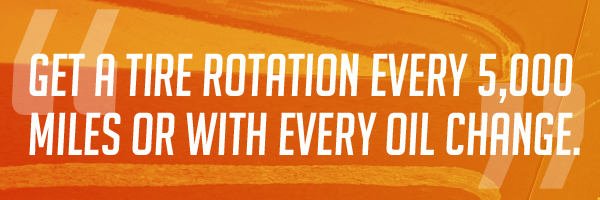Tire Rotation: Why It’s Important and How Often You Should Do It
August 06, 2020
Tires are pretty straightforward, right? They’re just rubber and air that keep your vehicle on the road. In truth, there’s more to tires and tire maintenance than just airing them up or changing a flat.
When it comes to vehicle maintenance, most people are aware of the basics like getting the oil changed and watching for wiper blades to wear out. But, tire maintenance is another basic that often gets overlooked.
In addition to checking the tread and pressure, tires need to be rotated and balanced on a regular basis.

Why you should get your tires rotated
First things first: Don’t confuse tire rotation with an alignment. An alignment should happen whenever you get a new set of tires. (If you didn’t know this already, no worries. Just be sure to have the shop do this the next time you get a new set.)
A tire rotation is when the shop rotates the placement of your tires on the vehicle, changing up from front to back and side to side. Many people underestimate just how much a tire rotation can maintain the life of your tires.
When you should get your tires rotated
Frequently rotating your tires helps ensure they wear as smoothly and subtly as possible. (Wear= breakdown of the tread.) The point of rotating is to avoid tires that wear faster in the front or rear of the car or abnormal wear across the top of the tire.
Recommendations vary for how often you should be rotating your tires. But, a safe rule of thumb is to rotate those tires every 5,000 miles or with every oil change if that falls close to that same mark.
Get the most out of those tires by getting them rebalanced every third rotation or so.
What’s a tire rebalance?
Everyday wear and typical manufacturing imperfections cause tire imbalances. Tires don’t have perfectly equal weight distribution and even a small difference can cause noticeable drivability issues. Read: vibration.
When a technician rebalances your tires, they hook each wheel up to a balancing machine and then test for vibrations in the wheel when it spins.
The vibrations tell the technician if they need to add weight and where they should add it so the tire balances. This is important because it will help prolong the wear and tear on your tires as well.

Pro tip: There are a few cars on which you can’t perform tire rotations. Often these are sports cars or vehicles built to be more “sporty” in general.
This is usually due to staggered wheel sizes, meaning the front and rear wheels are different sizes. When this is the case, you can’t move the tires from front to back (or vice versa) because it either wouldn’t fit, it would change how the car drives, or, possibly, both.
For more helpful tips and tricks on maintaining your vehicles or frequently asked questions, contact your trusted BG Advisor. Until next time, stay safe, and protect your investments!
 By Jon Hansen
By Jon Hansen
Central Kansas Territory Manager, Kansas BG
Jon works with dealerships as well as independent garages of all types and sizes. He has almost 13 years of technician experience before starting his BG career. In addition to BG, Jon does freelance writing and photography for multiple magazines on newsstands including Street Trucks Magazine, C10 Builders Magazine, and Tread Magazine.
